


![]()
![]()
Though the beats in this lesson appear simple in print they will prove very frustrating to all but the most avid rudiment freaks. You will actually be executing single stroke and double stroke rolls at extremely rapid tempos when performing these beat patterns. The truth is, these beats are somewhat useless at slow tempos and seemingly impossible at quick tempos for all but those who have devoted many hours to the above mentioned rudiments.
THE GOOD NEWS: There are easier substitute beat patterns we can use in place of these patterns. We might play a lifetime without these beats and never have a problem. So, if they drive you crazy and leave you frustrated . . . DON'T PANIC! You can put them on the back-burner for study at a later time.
MORE GOOD NEWS: Mastery of these patterns will automatically help students develop enviable mastery with the specific rudiments (singles RLRL and doubles RRLL) in question. In other words . . . you will be learning beats that will also help you get a grip on those boring rudiments that always need so much additional effort. With enough time and effort expended on these patterns you will enjoy greater flexibility over-all, around the kit. In essence you are mastering two very important rudiments as you master these dancebeat rhythms. These beat patterns can help a student develop the technical polish and control that will otherwise only occur as a result of effort expended with rudimental repetition. This means that any effort you expend here won't be wasted. Most of us need the rudimental practice anyway!
MORE GOOD NEWS: After many years of teaching these patterns I have developed a stair-step process with these beats that will make the patterns appear overly simple in the beginning stages. Just the same, I have noticed that most students return weeks later, with signs of frustration and defeat in their eyes.
You will eventually find uses for the simpler stages and by using the easy forms at first, the more difficult stages will gradually develop and grow over a period of time. One day . . . (ummm . . . more like 6-months) later . . . you will gravitate towards the more difficult stages when your hands, feet and mind are ready. Even the difficult stages are easy to comprehend but they may be very difficult to play at extremely quick tempos, (which is the whole point of the lesson).
The problem is: these beats are only valuable at quick tempos . . . they aren't often used in slow tempos. This means we need to be fast with them, coming out of the gate. THAT will require a lot of boring repetition.
All of the above discussion has been added to simply help you avoid being too hard on yourself if you hit a brick wall here.
So;Improvement will occur gradually, with time. As we study the classic 'fills' and as we begin using those fills when jamming with every-day music, the rolls will quickly improve on their own.
Just prior to driving a drumstick through your batter head in frustration . . . move on to a different topic. You might play 60 years and make millions of dollars without knowing these beats. Don't let them bring you down.
 EASY-PEASY! Listen to the sound file.
EASY-PEASY! Listen to the sound file.
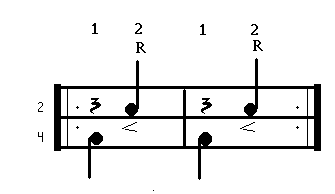
STEP #2:
Now we'll play a quick double right hand with every other repetition. The tempo
should remain the same. Notice the '<' accent mark below the backbeat. We
need to play that note a tad louder than all the rest. My dumb little midi file
maker had a problem with the accent and I had to fudge a little to get the sound
we need. I would love to use a real drum set here but regrettably, it is a major
gig, trying to get an acoustic drumset to make midi files. (My video-camera bought the farm.
When I get another I will create a video for this lesson.)
 Listen, as the plot thickens . . .
Listen, as the plot thickens . . .
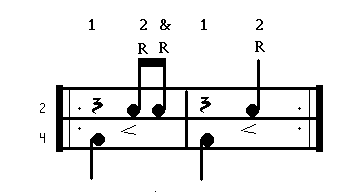 STEP #3:
STEP #3: NOW, add the left hand with
each downbeat. Hold the tempo solid and as fast as before.
NOW, add the left hand with
each downbeat. Hold the tempo solid and as fast as before.
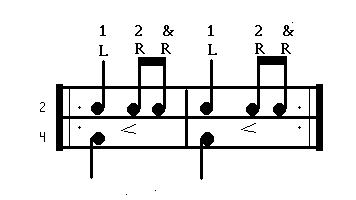 STEP #4:
STEP #4:Another name for this beat might be the 'Train Beat'. What a dumb name, haha. Why would they call it that? Play it with brushes and you'll hear the reason. Be sure to play a bass drum note along with the first left-hand and always accent the first right-hand.
 Listen for the train. "I think I can, I think I can, I think I can."
Listen for the train. "I think I can, I think I can, I think I can."
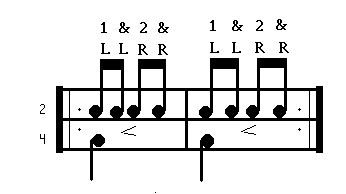
OK . . . I'm going to assume that 10 years have passed and you are playing the above beat pattern at the speed of light (or about twice the speed of the midi file). Grab your brushes and play around with it. When played with brushes this beat pattern becomes a super background rhythm for hundreds of smokin' jazz tunes. You will also hear it with Punk music, Rockabilly and Country & Western styles as well.
Remember this as well, . . . each bass drum note could potentially be the beginning or end of any of your previously studied fills. Try them all within this structure: Singles, doubles, triplets, press rolls, paradiddles and . . . the works. Be able to play any of your routine fills without losing tempo . . . or falling off the drum-throne with heart palpitations.
MORE? Yes! This is also important: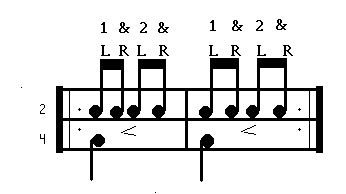
 Yes, it sounds the same,
but it is great to know the beat both ways . . . That way, as your hands
grow numb in the 90th minute of a jamming jazz tune . . . you can always
switch strokes in mid song, placing the stress on the opposite hand.
Yes, it sounds the same,
but it is great to know the beat both ways . . . That way, as your hands
grow numb in the 90th minute of a jamming jazz tune . . . you can always
switch strokes in mid song, placing the stress on the opposite hand.
Err-Ohh! This too, is extremely important:
AS A PARTING THOUGHT . . . try reversing the hand you begin with.
In other words, rather than beginning the beat with the left hand as it is
written above . . . reverse it . . . and start with your right hand. Be sure to accent
the backbeats, which will now fall on the other hand. Yikes!
![]() Copyright Bill Powelson 1965-1996-2008-2014 @ all rights reserved.
Copyright Bill Powelson 1965-1996-2008-2014 @ all rights reserved.
![]()
![]()

![]()
Musical Time - Finite to Infinity:
Finite to Infinity:
Learn to easily jam and play music comfortably within any odd or even time signature. This material isn't currently taught in music-theory classes, yet it is simple enough for grade-school students. Discover more than 18 quintillion unique and different (modern music) song-beat structures.Discover the (lost) 500 year-old enigmatic secrets hidden within the current time-signature system. Seven short mesmerizing and easy-to-follow lessons will lead you quickly and easily towards (musical-time) guru status. You will learn to visualize (read, write or feel) the existence This should lead directly to the e-book.

This very informative little booklet will amaze you with hundreds of valuable tips and insider secrets! HOW TO: Purchase old/used drumsets for pennies and resell them for decent profits.